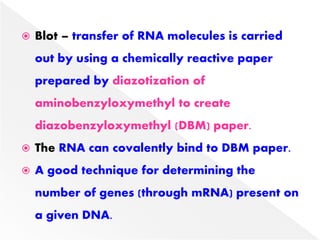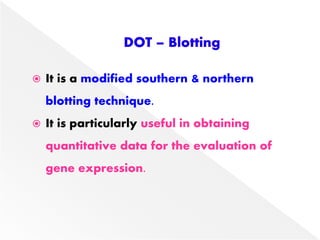BLOTTING TECHNIQUES
- 2. Analytical tools for the specific identification of desired DNA or RNA fragments from thousands of molecules. Blotting is a process of immobilization of sample nucleic acids on solid support (nitrocellulose or nylon membranes). Blotted nucleic acids are used as targets in the hybridization experiments.
- 3. Southern blotting (for DNA) Northern blotting (for RNA) Dot blotting (DNA/RNA)
- 4. It is technique for blotting DNA. The genomic DNA isolated from cell/tissues is digested with one or more restriction enzymes. This mixture is loaded into a well in an agarose or polyacrylamide gel & subjected to electrophoresis. The negatively charged DNA migrates to wards the anode (positively charged electrode). Smaller DNA fragments move faster.
- 5. The separated DNA molecules are denatured by exposure to a mild alkali & transferred to nitrocellulose or nylon paper. This results in an exact replica of the pattern of DNA fragments on the gel. The DNA can be annealed to the paper on exposure to heat (80˚C). Nitrocellulose or nylon paper is exposed to labeled cDNA probes.
- 6. These probes hybridize with complementary DNA molecules on the paper. The paper after thorough washing is exposed to X-ray film to develop autoradiograph. This reveals specific bands corresponding to DNA fragments recognized by cDNA probe.
- 8. It is an invaluable method in gene analysis. Important for the confirmation of DNA cloning results. Highly useful for the determination of restriction fragment length polymorphism (RFLP) associated with pathological conditions.
- 9. It is a technique for specific identification of RNA molecules. RNA molecules are subjected to electrophoresis, followed by blot transfer, hybridization & autoradiography. RNA molecules do not easily bind to nitrocellulose paper or nylon membrane.
- 10. Blot – transfer of RNA molecules is carried out by using a chemically reactive paper prepared by diazotization of aminobenzyloxymethyl to create diazobenzyloxymethyl (DBM) paper. The RNA can covalently bind to DBM paper. A good technique for determining the number of genes (through mRNA) present on a given DNA.
- 12. It is a modified southern & northern blotting technique. It is particularly useful in obtaining quantitative data for the evaluation of gene expression.
- 13. It involves the identification of proteins. It is very useful to understand the nucleic acid functions, particularly during the course of gene manipulations. It involves transfer of electrophoresed protein bands from polyacrylamide gel to nylon or nitrocellulose membrane. These proteins can be detected by specific protein-ligand interactions. Antibodies or lectins are commonly used for this purpose.
- 14. Autoradiography is the process of localization & recording of a radiolabel within a solid specimen, with the production of an image in a photographic emulsion. These emulsions are composedo f silver halide crystalss uspended in gelatin.
- 15. β-particle or a γ-ray from a radiolabel passes through the emulsions, silver ions are converted to metallic silver atoms. This results in the development of a visible image which can be easily detected. Applications: Autoradiography is closely associated with blotting techniques for the detection of DNA, RNA & proteins.
- 16. Textbook of Biochemistry – U Satyanarayana
















